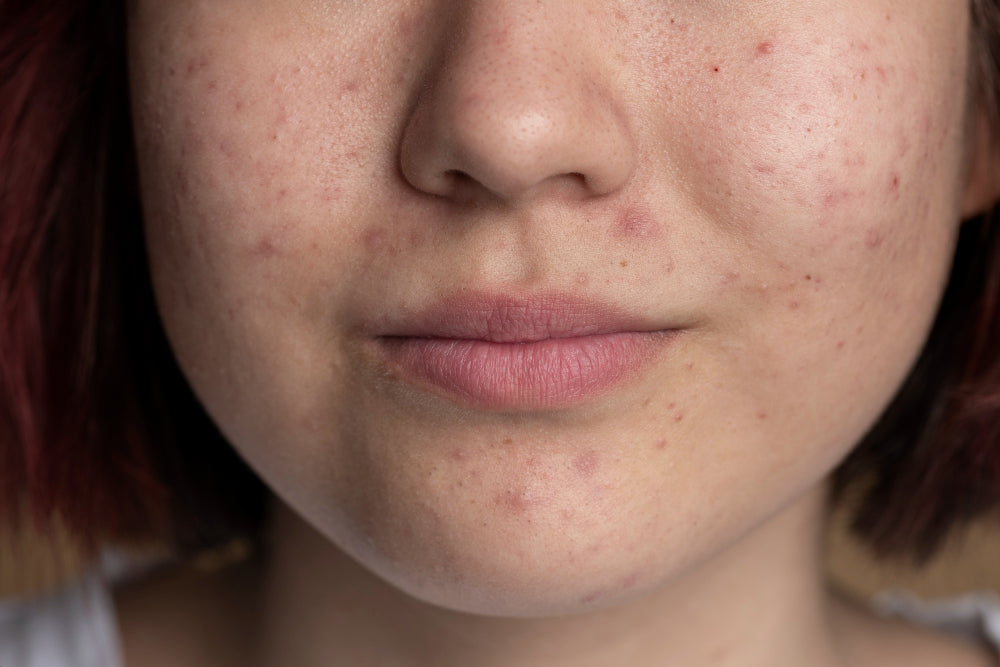
Period Acne: The Ultimate Guide to Hormonal Breakouts
Share
Period acne is a common skin concern experienced by many women during their menstrual cycle. Hormonal breakouts can be frustrating and challenging to manage, leading to decreased confidence and self-esteem. Understanding the causes and treatment options for period acne is essential for improving skin health and overall well-being.
How Hormones Affect Your Skin
The menstrual cycle consists of four phases: follicular, ovulatory, luteal, and menstrual. Hormones, including estrogen, progesterone, and androgens, play a significant role in acne development. Estrogen and progesterone help regulate sebum production, while androgens can increase sebum production, leading to clogged pores and acne.
Changes in hormone levels during the menstrual cycle can also impact skin. The luteal phase, which occurs after ovulation, is when androgen levels rise, and many women experience acne breakouts during this time.
Causes of Period Acne
The relationship between the menstrual cycle and acne is complex, and there are several factors that can trigger acne during menstruation. Common triggers include stress, changes in hormone levels, and premenstrual syndrome (PMS). Additionally, certain lifestyle habits such as diet, lack of exercise, and poor skincare routines can increase the likelihood of experiencing period acne.
What Does Period Acne Look Like?
Hormonal acne is typically characterized by deep, cystic breakouts that occur along the jawline, chin, and cheeks. Unlike other types of acne, hormonal acne tends to be more painful and persistent, and it can take longer to heal. Identifying acne patterns during the menstrual cycle can help pinpoint the cause of breakouts and guide treatment options.
Hormonal Acne Treatment Options
There are several treatment options for hormonal acne, including topical treatments, oral medications, and natural remedies. Topical treatments, such as benzoyl peroxide and salicylic acid, can help unclog pores and reduce inflammation. Oral medications, such as birth control pills and spironolactone, can help regulate hormone levels and reduce sebum production. Natural remedies, such as tea tree oil and green tea, can also help improve acne symptoms.
Lifestyle Changes to Manage Period Acne
In addition to medical treatments, lifestyle changes can also help manage period acne. Eating a balanced diet, exercising regularly, and managing stress levels can all help reduce the likelihood of experiencing hormonal breakouts. Additionally, adopting a consistent skincare routine and using products specifically formulated for acne-prone skin can help prevent and treat breakouts.
How to treat Hormonal Acne at home?
-
Tea Tree Oil: Tea tree oil is a natural anti-inflammatory and antiseptic agent. It can help reduce inflammation and fight acne-causing bacteria. Dilute the tea tree oil with a carrier oil, such as coconut or jojoba oil, before applying it to the skin.
-
Apple Cider Vinegar: Apple cider vinegar contains acetic acid, which can help exfoliate the skin, reduce inflammation, and fight bacteria. Mix equal parts of apple cider vinegar and water, and apply it to the affected area with a cotton ball. Rinse it off after a few minutes.
-
Honey: Honey has antibacterial and anti-inflammatory properties. Apply raw honey directly to the affected area and leave it on for 10-15 minutes before rinsing it off.
-
Aloe Vera: Aloe vera has a soothing effect on the skin and can help reduce inflammation. Apply fresh aloe vera gel directly to the affected area and leave it on for 15-20 minutes before rinsing it off.
-
Turmeric: Turmeric contains curcumin, a compound that has anti-inflammatory and antioxidant properties. Mix turmeric powder with water to form a paste and apply it to the affected area. Leave it on for 10-15 minutes before rinsing it off.
-
Green Tea: Green tea contains antioxidants that can help reduce inflammation and fight acne-causing bacteria. Brew green tea and allow it to cool before applying it to the affected area with a cotton ball. Leave it on for 10-15 minutes before rinsing it off.
-
Witch Hazel: Witch hazel has astringent properties that can help reduce inflammation and oil production. Apply witch hazel to the affected area with a cotton ball.
-
Lemon Juice: Lemon juice contains citric acid, which can help exfoliate the skin and reduce oil production. Apply lemon juice to the affected area with a cotton ball and leave it on for 10-15 minutes before rinsing it off.
-
Baking Soda: Baking soda has exfoliating properties that can help unclog pores and reduce inflammation. Mix baking soda with water to form a paste and apply it to the affected area. Leave it on for 10-15 minutes before rinsing it off.
-
Zinc Supplements: Zinc can help reduce inflammation and regulate hormone levels. Take zinc supplements after consulting with a healthcare professional.
Hormonal Acne and Birth Control
Birth control can be an effective treatment option for hormonal acne, as it can help regulate hormone levels and reduce sebum production. Different types of birth control, such as combination pills and progestin-only pills, have varying levels of effectiveness in treating acne. It's important to consult with a healthcare provider to determine the best type of birth control for individual needs.
How many days does period acne last?
The duration of period acne varies for each individual and depends on factors such as the severity of the acne, the person's menstrual cycle, and the effectiveness of treatment. Generally, period acne can last anywhere from a few days to several weeks, and it may start to clear up on its own once hormone levels stabilize. However, if the acne is severe or persistent, it is recommended to consult with a dermatologist to determine the best treatment options.
When to Seek Professional Treatment
While many cases of period acne can be effectively managed through lifestyle changes and over-the-counter treatments, severe or persistent acne may require professional treatment. Consulting with a dermatologist can help determine the best course of treatment, which may include prescription medications or in-office procedures.
